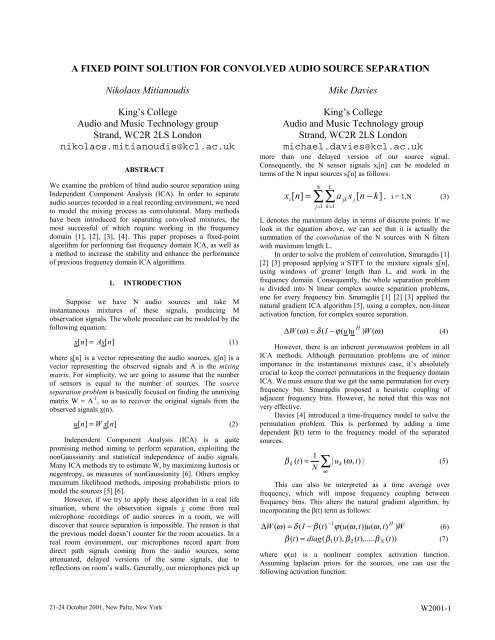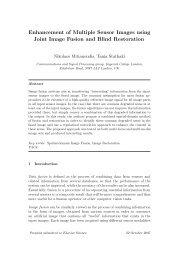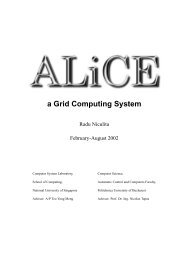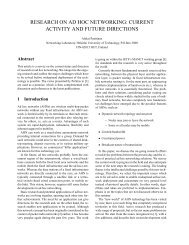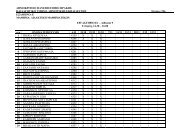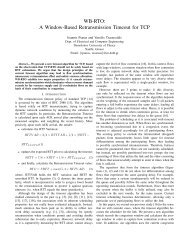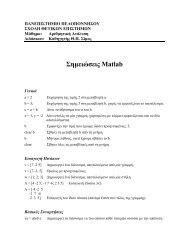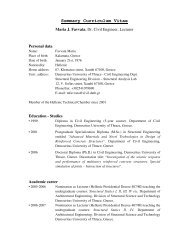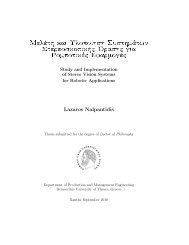pdf - Utopia
pdf - Utopia
pdf - Utopia
You also want an ePaper? Increase the reach of your titles
YUMPU automatically turns print PDFs into web optimized ePapers that Google loves.
A FIXED POINT SOLUTION FOR CONVOLVED AUDIO SOURCE SEPARATION<br />
Nikolaos Mitianoudis Mike Davies<br />
King’s College<br />
Audio and Music Technology group<br />
Strand, WC2R 2LS London<br />
nikolaos.mitianoudis@kcl.ac.uk<br />
ABSTRACT<br />
We examine the problem of blind audio source separation using<br />
Independent Component Analysis (ICA). In order to separate<br />
audio sources recorded in a real recording environment, we need<br />
to model the mixing process as convolutional. Many methods<br />
have been introduced for separating convolved mixtures, the<br />
most successful of which require working in the frequency<br />
domain [1], [2], [3], [4]. This paper proposes a fixed-point<br />
algorithm for performing fast frequency domain ICA, as well as<br />
a method to increase the stability and enhance the performance<br />
of previous frequency domain ICA algorithms.<br />
1. INTRODUCTION<br />
Suppose we have N audio sources and take M<br />
instantaneous mixtures of these signals, producing M<br />
observation signals. The whole procedure can be modeled by the<br />
following equation:<br />
x [ n]<br />
= As[<br />
n]<br />
(1)<br />
where s[n] is a vector representing the audio sources, x[n] is a<br />
vector representing the observed signals and A is the mixing<br />
matrix. For simplicity, we are going to assume that the number<br />
of sensors is equal to the number of sources. The source<br />
separation problem is basically focused on finding the unmixing<br />
matrix W ≈ A -1 , so as to recover the original signals from the<br />
observed signals x(n).<br />
u [ n]<br />
= W x[<br />
n]<br />
(2)<br />
Independent Component Analysis (ICA) is a quite<br />
promising method aiming to perform separation, exploiting the<br />
nonGaussianity and statistical independence of audio signals.<br />
Many ICA methods try to estimate W, by maximizing kurtosis or<br />
negentropy, as measures of nonGaussianity [6]. Others employ<br />
maximum likelihood methods, imposing probabilistic priors to<br />
model the sources [5] [6].<br />
However, if we try to apply these algorithm in a real life<br />
situation, where the observation signals x come from real<br />
microphone recordings of audio sources in a room, we will<br />
discover that source separation is impossible. The reason is that<br />
the previous model doesn’t counter for the room acoustics. In a<br />
real room environment, our microphones record apart from<br />
direct path signals coming from the audio sources, some<br />
attenuated, delayed versions of the same signals, due to<br />
reflections on room’s walls. Generally, our microphones pick up<br />
King’s College<br />
Audio and Music Technology group<br />
Strand, WC2R 2LS London<br />
michael.davies@kcl.ac.uk<br />
more than one delayed version of our source signal.<br />
Consequently, the N sensor signals x i[n] can be modeled in<br />
terms of the N input sources s i[n] as follows:<br />
∑∑<br />
j=<br />
1 k = 1<br />
21-24 October 2001, New Paltz, New York W2001-1<br />
x<br />
i<br />
n]<br />
=<br />
N<br />
L<br />
[ , i = 1,N (3)<br />
a<br />
jk<br />
s [ n − k]<br />
j<br />
L denotes the maximum delay in terms of discrete points. If we<br />
look in the equation above, we can see that it is actually the<br />
summation of the convolution of the N sources with N filters<br />
with maximum length L.<br />
In order to solve the problem of convolution, Smaragdis [1]<br />
[2] [3] proposed applying a STFT to the mixture signals x[n],<br />
using windows of greater length than L, and work in the<br />
frequency domain. Consequently, the whole separation problem<br />
is divided into N linear complex source separation problems,<br />
one for every frequency bin. Smaragdis [1] [2] [3] applied the<br />
natural gradient ICA algorithm [5], using a complex, non-linear<br />
activation function, for complex source separation.<br />
H<br />
∆ W ( ω) = δ ( I −ϕ<br />
( u)<br />
u ) W ( ω)<br />
(4)<br />
However, there is an inherent permutation problem in all<br />
ICA methods. Although permutation problems are of minor<br />
importance in the instantaneous mixtures case, it’s absolutely<br />
crucial to keep the correct permutations in the frequency domain<br />
ICA. We must ensure that we get the same permutation for every<br />
frequency bin. Smaragdis proposed a heuristic coupling of<br />
adjacent frequency bins. However, he noted that this was not<br />
very effective.<br />
Davies [4] introduced a time-frequency model to solve the<br />
permutation problem. This is performed by adding a time<br />
dependent β(t) term to the frequency model of the separated<br />
sources.<br />
1<br />
β k ( t) = ∑|<br />
uk<br />
( ω,<br />
t)<br />
|<br />
(5)<br />
N<br />
ω<br />
This can also be interpreted as a time average over<br />
frequency, which will impose frequency coupling between<br />
frequency bins. This alters the natural gradient algorithm, by<br />
incorporating the β(t) term as follows:<br />
−1<br />
∆ W ( ω)<br />
= δ ( I − β ( t)<br />
H<br />
ϕ(<br />
u(<br />
ω,<br />
t))<br />
u(<br />
ω,<br />
t)<br />
) W (6)<br />
β ) = diag(<br />
β ( t),<br />
β ( t),.....<br />
β ( t))<br />
(7)<br />
( t 1 2 N<br />
where φ(u) is a nonlinear complex activation function.<br />
Assuming laplacian priors for the sources, one can use the<br />
following activation function:
W2001-2<br />
ϕ ( u ) = u / | u |<br />
(8)<br />
In order to fix the permutation problem, we can apply a<br />
likelihood ratio jump. For the 2x2 case, we actually compare the<br />
likelihood of the unmixing matrix W with that of [0 1; 1 0] W.<br />
We calculate LR using the following formula and if LR< 1, we<br />
have to permute W.<br />
where<br />
γ γ<br />
LR =<br />
(9)<br />
γ<br />
12 21<br />
11γ<br />
22<br />
T<br />
∑<br />
t=<br />
1<br />
ui<br />
( t)<br />
γ ij =<br />
(10)<br />
β ( t)<br />
j<br />
This method seems to be capable of sorting out the permutation<br />
problem in the majority of the cases.<br />
2. EXTENSIONS<br />
A common problem in an adaptive learning procedure as<br />
described in (4) and (6) is that we have to ensure the algorithm’s<br />
stability. In other words, if we don’t set the increment step<br />
correctly, the algorithm may skip the desired stationary point<br />
and may not finally converge.<br />
At first, one might say that the increment step can be<br />
controlled by the learning rate δ. If we are using the formula to<br />
separate instantaneously mixed sources, we can set a proper δ<br />
that allows convergence. However, in the frequency domain<br />
case, we have N separation problems. For each frequency bin,<br />
input signals x(ω,t) have completely different signal levels. It’s<br />
well known that audio signals have greater low frequency terms<br />
than high frequency terms. As a consequence, keeping a<br />
constant learning rate in the formula for every frequency bin<br />
may hinder the convergence of the algorithm in some frequency<br />
bins. This can give a reason why this method cannot perform<br />
good separation in the higher frequency bins (Smaragdis [1] [2]<br />
[3]).<br />
We can ensure the algorithm convergence by setting a<br />
different learning for every frequency bin. However, a more<br />
elegant way to ensure stability is to calculate the signal level for<br />
every frequency bin and then normalize the signal with the<br />
signal level before separating. This ensures that input signals<br />
x(ω,t) have the same variance for every frequency bin and<br />
therefore we can use the same learning rate in our separation<br />
algorithm. We store the signal levels and multiply u(ω,t) after<br />
separation.<br />
X n ( ω,<br />
t)<br />
X n ( ω, t)<br />
← (11)<br />
var(| X ( ω,<br />
t)<br />
|)<br />
X<br />
n<br />
n<br />
X n ( ω,<br />
t)<br />
( ω, t)<br />
← (12)<br />
max(| X ( ω,<br />
t)<br />
|)<br />
n<br />
As a signal level metric, we can use either the standard deviation<br />
(10) or the absolute maximum (11) of the complex sequence.<br />
We can also interpret this normalization scheme, as an attempt<br />
to force the algorithm pay equal attention to every frequency<br />
bin.<br />
3. A FIXED POINT SOLUTION<br />
Hyvarinen et al proposed a family of fixed point ICA<br />
algorithms for performing ICA of instantaneous mixtures [6] [7]<br />
[8]. The basic advantage of these ICA algorithms is that they<br />
converge much faster than gradient descent algorithms with the<br />
same separation quality. Their disadvantage is that they are more<br />
computationally expensive, but as the number of iterations for<br />
convergence is much decreased, they tend to be faster then<br />
common ICA techniques.<br />
In [8], Hyvarinen explored the connection of his fixedpoint<br />
algorithm with the natural gradient algorithm [5]. The<br />
fixed-point algorithm is basically a deflation algorithm, isolating<br />
one independent component every time. It employs a<br />
decorrelation scheme to prevent the algorithm converging to the<br />
same maximum. The one-unit learning rule for the fixed-point<br />
algorithm is the following:<br />
w<br />
1<br />
← − +<br />
C<br />
T<br />
E{<br />
xϕ<br />
( w x)}<br />
− E{<br />
ϕ'<br />
( w<br />
x)}<br />
w<br />
2001 IEEE Workshop on Applications of Signal Processing to Audio and Acoustics<br />
T<br />
T<br />
(13)<br />
where C = E{<br />
xx<br />
} and ϕ(u) is an activation function.<br />
Making certain assumption on x, Hyvarinen shows that the<br />
learning rule can be represented by the following rule:<br />
W<br />
+<br />
← W + D[<br />
diag(<br />
−α<br />
) + E{<br />
ϕ(<br />
u)<br />
u<br />
i<br />
T<br />
}] W<br />
(14)<br />
where α i = E{ uiϕ<br />
( ui<br />
)} , D = diag(<br />
1/(<br />
α i − E{<br />
ϕ'<br />
( u)}))<br />
and<br />
[ 1 2 ... N ] w w w W = . If we compare equations (14) and (4), we<br />
will see that the two methods look very similar. In fact, (14) is a<br />
more adaptive version of (4). Instead of a constant learning rate<br />
δ, we apply an optimal step size in terms of D. Replacing I by<br />
diag(-αi) is beneficial for convergence speed [8]. If we use prewhitened<br />
data x, then the formula in (14) is equivalent to the<br />
original fixed-point algorithm, while it is expressed in terms of<br />
the natural gradient algorithm.<br />
This algorithm achieves fast, excellent separation of<br />
instantaneous mixtures. Here we wish to replace the natural<br />
gradient algorithm with the fixed-point algorithm, as described<br />
in (14), in the frequency domain framework, so as to accelerate<br />
the convergence of audio separation algorithms.<br />
More specifically, we are going to divide our observation<br />
signals into overlapping windowed frames, and take the STFT<br />
forming a time-frequency representation x(ω,t). We pre-whiten<br />
x(ω,t) before proceeding. The next step is to estimate the<br />
unmixing matrix for every frequency bin. This is achieved by<br />
iterating the following equation, using random initial value for<br />
W.<br />
W<br />
+<br />
← W + D[<br />
diag(<br />
−α<br />
) + E{<br />
ϕ(<br />
u)<br />
u<br />
i<br />
H<br />
}] W<br />
(15)<br />
All the parameters in the equation above are calculated as<br />
discussed earlier. However, we should pay attention to the
choice of the activation function φ(u). A proper activation<br />
function for the processing of complex data is (8), as introduced<br />
by Davies [4]. By differentiating, we get the derivative of φ:<br />
−1 −<br />
2<br />
−3<br />
ϕ ' ( u)<br />
= | u | u | u | , for all u ≠ 0 (16)<br />
Another thing we should take into account is the permutation<br />
problem. In order to solve the permutation problem in this case,<br />
we can follow a method similar to the one described earlier.<br />
Firstly, we enhance frequency coupling by adding a time<br />
dependent β(t) term to the frequency model of the separated<br />
sources, as we did in the natural gradient method. If we look at<br />
(6), we might say that the β(t) term can be incorporated in the<br />
activation function φ(u). Therefore, in order to impose frequency<br />
coupling in the fixed-point algorithm, we can use the following<br />
activation function in (15).<br />
u<br />
ϕ ( u)<br />
= (17)<br />
β ( t)<br />
| u |<br />
As a second step, we use the likelihood ratio jump solution, as<br />
presented in (9), (10), in order to get the same permutation of<br />
the separated sources for every frequency bin.<br />
Another important issue when performing frequency<br />
domain ICA is to return the separated signals u to their original<br />
space (represented by x vectors). More specifically, if W f is the<br />
unmixing matrix for the frequency bin f, we can write:<br />
−1<br />
xi s j<br />
fij<br />
j<br />
( f , t)<br />
= W u ( f , t)<br />
, for i ,j = 1…N (18)<br />
Note that for pre-whitened sources, we also need to return<br />
the sources to the original space before pre-whitening. Suppose<br />
that V f is the pre-whitening matrix for each frequency bin. We<br />
have:<br />
T −1<br />
[ 1s<br />
j ... x N s j ] V f [ x1<br />
x = s ... x s ] , j=1…N (19)<br />
After performing all these linear transforms, we can group<br />
the x is j signals to form the separated outputs as follows:<br />
∑<br />
j<br />
u<br />
~<br />
( f , t)<br />
= x s ( f , t)<br />
, for j = 1…N (20)<br />
j<br />
i<br />
i<br />
j<br />
The new fixed-point frequency domain algorithm is<br />
summarised as follows:<br />
1. Pre-whiten input data<br />
2. Incorporate β(t) function in the activation function, i.e.<br />
use formula (17)<br />
3. For the derivative of (17), use (16) as an approximation<br />
4. Use the learning rule presented in (15), to estimate the<br />
umixing matrices for every frequency bin.<br />
5. Return separated signals to the observation space, as well<br />
as re-decorrelate separated signals.<br />
N<br />
4. EXPERIMENTS<br />
In our first series of experiments, we investigated the<br />
maximum likelihood method’s performance using the extensions<br />
presented in 2. Although the difference is not audible, the<br />
j<br />
T<br />
spectrograms of the separated sources tend to be smoother and<br />
closer to the original sources. Moreover, we never experienced<br />
any instability in the algorithm, whatever data we used. Actually,<br />
this was the main objective of the extensions.<br />
In a second series of experiments, we were looking into the<br />
fixed-point frequency domain algorithm’s performance. We<br />
tested the algorithm using different data sets.<br />
Initially, we applied it to some real data available from [9]<br />
of two people speaking simultaneously in a room, as they are<br />
commonly used in ICA benchmarks. Our first conclusion is that<br />
the fixed-point algorithm takes about 40-50 iterations to<br />
converge, which is much faster compared to common maximum<br />
likelihood algorithms. Commonly, the solutions proposed by<br />
Davies [4] and Smaragdis [1] [2] [3] require usually about 200 –<br />
300 iterations to converge for the same quality of separation.<br />
Convergence speed has become a quite important factor for<br />
frequency domain ICA, as previous approaches required<br />
considerable time to run. As far as the separation quality is<br />
concerned, we can say that you can almost hear no cross-talk.<br />
We tested the algorithm using the dataset proposed by<br />
Davies [4], which was used to demonstrate the permutation<br />
problem in Smaragdis ’s algorithm. The likelihood ratio jump<br />
solution combined with the frequency coupling imposed by (17)<br />
seemed to be working very well in this fixed-point framework,<br />
and the algorithm seems to have no problem sorting out the<br />
correct permutation. The convergence speed is quite fast, and the<br />
separation quality can be compared to that of the previous<br />
algorithms.<br />
In order to demonstrate the separation quality of the<br />
algorithm, we constructed a synthetic mixture of two sources.<br />
The mixtures contained delayed components of 25ms maximum,<br />
as well as the direct path signals. The fixed-point algorithm<br />
managed to separate the input sources quite well. We can see the<br />
spectrograms of the original and separated sources in figures 1,2.<br />
Figure 1. (a) Spectrogram of the original source and (b)<br />
spectrogram of the separated source using the fixed-point<br />
algorithm<br />
The separation quality is quite good, and almost all the<br />
frequency components of the original sources are preserved in<br />
the separated outputs. We can clearly see that there is no<br />
permutation problem visible or audible in these spectrograms.<br />
21-24 October 2001, New Paltz, New York W2001-3
The permutation problem is well described in [4], where it is<br />
shown that although some algorithms perform reasonable<br />
separation for every frequency bin, we can see source<br />
permutation changes at certain frequencies. As a result, each<br />
source estimate contains large proportions of both sources which<br />
are both audible.<br />
Another test was to apply the algorithm to audio signals.<br />
We used some real data available from [9] of somebody<br />
counting and some music playing simultaneously in a room. The<br />
results were equally satisfactory as with the previous<br />
experiments.<br />
Figure 2. (a) Spectrogram of the original source and (b)<br />
spectrogram of the separated source using the fixed-point<br />
algorithm<br />
Finally, we have also recorded two guitars playing triads in<br />
harmony and created a synthetic mixture using the mixing<br />
function, used in the previous example. This separation<br />
experiment is quite demanding, as there is strong correlation<br />
between the two sources, and it is even difficult for the human<br />
ear to separate them. Applying the fixed-point algorithm, we get<br />
quite promising results. Although there is some audible crosstalk,<br />
the algorithm provides reasonable separation of the two<br />
sources. These results are quite encouraging for instrument<br />
separation from audio recordings.<br />
W2001-4<br />
5. CONCLUSIONS<br />
In this study, we have shown that we can improve the<br />
performance and the stability of maximum likelihood ICA<br />
methods, by introducing a pre-scaling of the time-frequency<br />
input data before processing.<br />
Moreover, we have introduced a new fixed-point algorithm<br />
for frequency domain source separation of convolved mixtures.<br />
The algorithm proved to be more stable and faster compared to<br />
former maximum likelihood approaches, as it is based on a<br />
second order optimization method. The quality of the separation<br />
is quite good, although there is a small amount of cross-talk.<br />
Furthermore, the likelihood ratio jump solution introduced<br />
in [4] proved to be able to solve the permutation problem, even<br />
in a fixed-point framework. However, this likelihood test<br />
becomes more complicated for more than two sources.<br />
In future, we hope to formulate this likelihood ratio jump<br />
test for more sources. Moreover, we hope to improve the<br />
performance and speed of this fixed-point solution as well as<br />
introduce more sophisticated time-frequency models.<br />
6. REFERENCES<br />
[1] Smaragdis P., "Efficient Blind Separation of Convolved<br />
Sound Mixtures", IEEE ASSP Workshop on Applications of<br />
Signal Processing to Audio and Acoustics. New Paltz NY,<br />
October 1997.<br />
[2] Smaragdis P., "Blind Separation of convolved mixtures in<br />
the frequency domain", International Workshop on<br />
Independence & Artificial Neural Networks University of<br />
La Laguna, Tenerife, Spain, February 9 - 10, 1998.<br />
[3] Smaragdis P., "Information Theoretic Approaches to Source<br />
Separation", May 1997, Masters Thesis, MIT Media Lab<br />
[4] Davies M., "Audio Source Separation", Mathematics in<br />
Signal Processing V, 2000.<br />
[5] Amari S., Cichocki A., Yang H. H., "A new learning<br />
algorithm for blind source separation", Advances in Neural<br />
Information Processing Systems, pp. 757-763, MIT Pres,<br />
Cambridge MA, 1996.<br />
[6] Hyvarinen A., "Survey on Independent Component<br />
Analysis”, Neural Computing Surveys 2:94--128, 1999<br />
[7] Hyvärinen A., Oja E., "A Fast Fixed-Point Algorithm for<br />
Independent Component Analysis", Neural Computation,<br />
9(7):1483-1492, 1997.<br />
[8] Hyvarinen A., "The Fixed-point Algorithm and maximum<br />
likelihood estimation for Independent Component Analysis",<br />
Neural Processing Letters, 10(1):1-5.<br />
[9] http://www.cnl.salk.edu/~tewon/ica_cnl.html<br />
[10] Bingham E., Hyvarinen A., " A fast fixed-point algorithm<br />
for independent component analysis of complex-valued<br />
signals", Int. J. of Neural Systems, 10(1):1-8, 2000.<br />
[11] Schobben D., Torkkola K., Smaragdis P., "Evaluation of<br />
blind signal separation methods", Proceedings of the<br />
Workshop on Independent Component Analysis and Blind<br />
Signal Separation, Aussois, France, January 11-15 1999.<br />
2001 IEEE Workshop on Applications of Signal Processing to Audio and Acoustics


